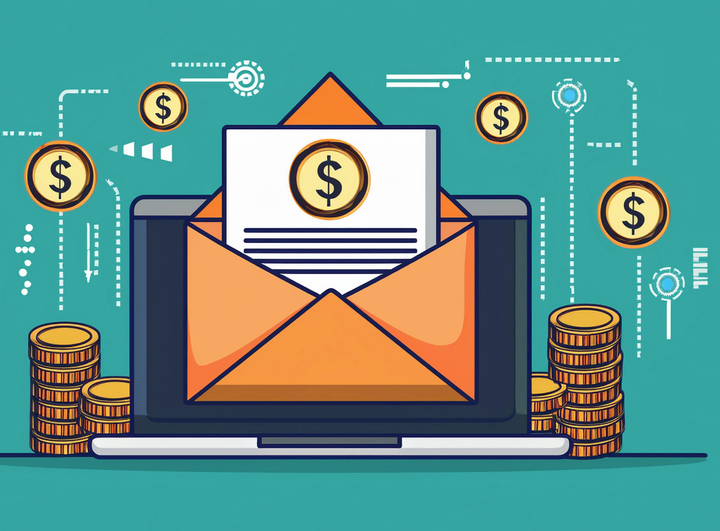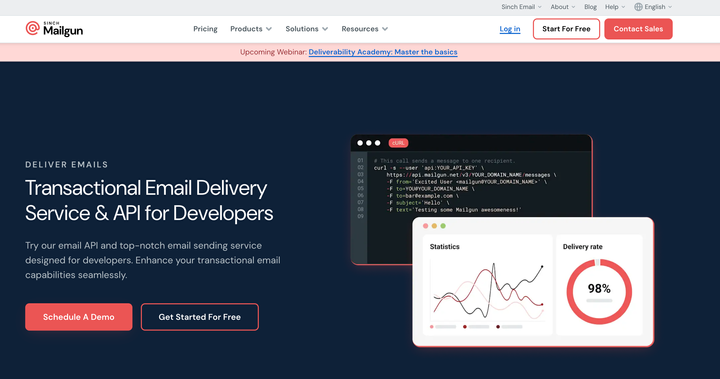Mastering Email Deliverability: Tips and Strategies for High Inbox Placement Rates
Master email deliverability with our guide. Learn key strategies to ensure your emails reach inboxes, from enhancing sender reputation and crafting effective content to managing lists and using authentication techniques.

Email deliverability is a crucial yet often overlooked aspect of successful email marketing. It's the art of ensuring your emails not only get sent but also successfully land in the recipient's inbox, avoiding the dreaded spam folder.
Emails have been crucial to the digital landscape and continue to hold their importance. Despite many different marketing avenues emerging over the years, email marketing remains the most efficient channel. In fact, for each $1 spent on email marketing, businesses reportedly see a $36 return on investment. Mastering email deliverability can be the difference between an email campaign's success or failure, translating to whether any business can thrive today.
With service providers like Maileroo emphasizing deliverability, understanding and implementing effective strategies to enhance inbox placement is more important than ever. Today, we will explore actionable tips and in-depth strategies to help you achieve high inbox placement rates, ensuring your emails reach their intended audience effectively.
From understanding the nuances of sender reputation to navigating the technical aspects of email authentication, we'll cover everything you need to know to become proficient in email deliverability.
Understanding the Fundamentals of Email Deliverability
Email deliverability is the measure of success in getting your emails landed in the recipient's inbox as opposed to being marked as spam or getting lost in the digital void. It is a critical factor in the effectiveness of email marketing campaigns. The journey of an email from 'sent' to 'successfully delivered' is complex and influenced by numerous factors, including sender reputation, email content, recipient engagement, and the intricacies of various email service providers.
There are many challenges in achieving high inbox placement rates. One primary challenge is navigating the ever-evolving algorithms of spam filters, which are designed to protect users from unsolicited emails but can sometimes incorrectly flag legitimate emails. Another challenge is maintaining a healthy sender reputation, a score that Internet Service Providers (ISPs) assign based on various factors like the volume of emails sent, frequency, and user engagement.
Understanding these challenges is the first step toward mastering email deliverability. Avoiding the spam folder is just a part of it. Successfully achieving email deliverability is also about ensuring your emails are welcomed by recipients with high open and engagement rates. This sets the stage for the various strategies that will be discussed in this blog, aimed at helping you achieve that goal.
Sender Reputation and its Role in Achieving Success with Email Marketing
Think of the sender reputation as the credit score for your email marketing campaign. Internet Service Providers (ISPs) consider your sender reputation when deciding whether they should route your email to a recipient’s inbox or slip it quietly into their spam folder. Having a good sender reputation increases the chances of your emails being successfully delivered. Similarly, a poor sender reputation will lead to your emails being filtered out or blocked.
To build a positive sender reputation, start with the basics: ensure that you have permission to email the recipients. This means using opt-in methods for building your email list rather than purchasing lists or adding emails without consent. Consistency in email volume and frequency also plays a role. Sudden spikes in email activity can trigger spam filters and negatively impact your reputation.
Engagement is another key factor. Emails that consistently receive high open and click-through rates are seen as valuable by ISPs, thus improving your reputation. On the other hand, high bounce rates and a large number of people unsubscribing can harm it.
Regular monitoring of your sender reputation is also essential. Tools like sender score services can provide insights into how ISPs view your email program. If you notice a decline in your sender reputation, it's crucial to take immediate action to identify and address the underlying issues, whether they're related to content, list quality, or frequency of emails.
Maintaining a positive sender reputation is an ongoing process. It requires a commitment to best practices in email marketing and a willingness to adapt to changing standards and recipient expectations.
Mastering Email Content to Ensure Better Email Deliverability By Creating Content That Enhances Inbox Placement
The content of your emails plays a pivotal role in determining their deliverability. Ensuring that your emails are both engaging and compliant with best practices can greatly increase the chances of them landing in the inbox.
Avoiding Spam Triggers
Nobody loves spam emails - not the recipient or ISPs filtering emails. Your email content should steer clear of words and phrases that are commonly associated with spam. Overly promotional language, excessive use of capitals, and multiple exclamation marks can trigger spam filters. It's important to craft your message in a way that is professional and straightforward. You can craft a well-written and impactful email that engages your target audience without filling it with unnecessary exclamation marks.
Relevance and Engagement
Content relevance is key to keeping your audience interested and engaged. Tailor your messages to suit your audience's preferences and behaviours. When you personalize content and make sure it resonates with the recipient, you automatically increase the chances of engagement. Sending irrelevant content in the emails will decrease the chances of anyone wanting to open it. If they don’t open your emails, it will harm your sender reputation. In turn, that will negatively impact your email deliverability.
Clear and Compelling Subject Lines
The subject line is the first impression of your email, and it almost always determines whether a recipient will bother engaging with the email. You do not want to waste the recipient’s time at all. To maximize the chances of getting them to click, it should be clear, concise, and intriguing without being misleading. A good subject line can significantly increase the open rate of your emails, enhancing your sender reputation.
Impactful and Relevant Call-to-Actions (CTAs)
Whether a transactional or marketing email, there is always going to be a point to it, right? You want the email to get some kind of response out of your recipient. This is where the call-to-action (CTA) comes in. Effective CTAs guide your recipients on what to do next. They should be clear, compelling, and relevant to the content of the email. A well-placed CTA can enhance user engagement, which is a positive signal for email service providers.
By focusing on creating high-quality, relevant content and avoiding common pitfalls, you can improve the deliverability of your emails and ensure they are well-received by your audience.
Effective Email List Management Strategies to Optimize Email Deliverability

Effective email list management is the key to unlocking high email deliverability rates and achieving success. In this section of the guide, we will explore a few of the most impactful strategies you should implement to this end.
Regular List Cleaning
Regularly remove inactive subscribers from your email list. Inactive subscribers can negatively impact your engagement rates and sender reputation. Use engagement metrics to identify and remove subscribers who haven't opened or clicked on your emails in a set period.
List Segmentation
Segment your email list based on demographics, past purchase behaviour, or engagement levels. This allows for more targeted and relevant email campaigns, which can lead to higher engagement and better deliverability.
Avoiding List Decay
Email lists naturally decay over time as people change their email addresses or lose interest. Continuously add new subscribers through opt-in methods to counteract this decay and keep your list fresh and engaged.
Double Opt-In
Implementing a double opt-in process where subscribers confirm their email addresses ensures that you are only adding valid and interested subscribers to your list. This can significantly reduce bounce rates and improve overall list quality. An email verification API assists in keeping your email list free of temporary and invalid addresses, ensuring cleaner and better email deliverability.
Re-engagement Campaigns
Periodically run re-engagement campaigns to reconnect with subscribers who have become less active. This can help revive interest and clean your list of those who do not re-engage.
By adopting these list management strategies, you can ensure that your email list remains a valuable asset for your email marketing efforts. A well-managed list leads to better engagement, which is a key factor in achieving high inbox placement rates.
Mastering Email Authentication Techniques to Enhance Email Deliverability
There are several aspects to maximize email deliverability, and email authentication plays a crucial role. By integrating email authentication, you can improve sender reputation and ensure that your emails are viewed as legitimate and secure by email service providers (ESPs). In this section, we will take a quick look at the most important email authentication techniques.
SPF (Sender Policy Framework)
SPF is an email authentication method that helps to prevent spammers from sending messages on behalf of your domain. It allows the domain owner to specify which mail servers are permitted to send email on behalf of their domain. When an email is received, the ESP checks the SPF record to ensure the email is coming from a server allowed by the domain's administrators. Unsure how to setup SPF? Check out our free SPF record generator!
DKIM (DomainKeys Identified Mail)
DKIM provides a way to validate a domain name identity associated with a message through cryptographic authentication. It allows the sender to attach a digital signature to emails. When an email is received, the receiving mail server uses the digital signature to verify that the email was not altered during transmission and that it comes from a legitimate source.
DMARC (Domain-based Message Authentication, Reporting, and Conformance)
DMARC builds on SPF and DKIM. It provides additional protection by allowing domain owners to indicate that their emails are protected by SPF and/or DKIM. It also instructs the ESP what to do if neither of those authentication methods passes – either reject the email or flag it as suspicious. This is a powerful tool for preventing email spoofing and phishing attacks.
Implementing these authentication techniques correctly is essential for ensuring your emails are trusted by ESPs and delivered to your recipients' inboxes.
Using Engagement Metrics to Refine Your Email Strategies

Email campaigns for any purpose only improve when you make decisions backed by data. If you want to improve deliverability, understanding essential facts will be critical in ensuring success. Here are a few key metrics that you can consider and how to leverage them for your email strategies.
Open Rate
The open rate indicates how many recipients are opening your emails. A low open rate could suggest issues with your subject lines or that your emails are being marked as spam. Improving subject lines and segmenting your list can help increase this metric.
Click-Through Rate (CTR)
CTR measures how many people clicked on links within your email. It reflects the relevance and interest generated by your email content. Enhancing the content quality and making calls-to-action (CTAs) more compelling can improve CTR.
Bounce Rate
The bounce rate is the percentage of your emails that weren’t delivered. There are two types of bounces – hard and soft. A high bounce rate may indicate problems with your email list quality or issues with your email server. Regular list cleaning and maintaining good server health is key to managing bounce rates.
Unsubscribe Rate
This metric shows how many people are opting out of your email list. A high unsubscribe rate might be a sign that your content is not resonating with your audience, or you're emailing too frequently. Adjusting your content strategy and email frequency can help reduce this rate.
By closely monitoring these engagement metrics, you can identify areas for improvement in your email campaigns. Regularly analysing and acting on these insights will lead to better email performance and higher deliverability rates.
Navigating the Challenges of Different Email Clients to Master Email Deliverability
Different email clients can display emails differently, which affects how your message is received. Here are some tips to ensure your emails look great across all platforms:
Responsive Design: Use responsive email design to ensure your emails look good on any device, whether it's a desktop, tablet, or smartphone.
Testing Across Clients: Regularly test your emails across different email clients (like Gmail, Outlook, Apple Mail) to ensure they render correctly.
Simplified Layouts: Use simple, clean email designs to avoid rendering issues in more restrictive email clients.
Avoid Over-Reliance on Images: Some email clients block images by default, so ensure your message comes across even without them.
Alt Text for Images: Always use alt text for images so recipients know what the image is about if it doesn't display.
Avoid Complex CSS: Stick to inline CSS and avoid complex styles that may not be supported by all email clients.
Adapting to the little intricacies of various email clients ensures a consistent and positive experience for all your recipients, irrespective of how they access their emails.
Mastering email deliverability is a multifaceted process that requires attention to various factors, from content creation to technical setup. By focusing on building a positive sender reputation, crafting effective content, managing your email list strategically, implementing authentication techniques, analyzing engagement metrics, and adapting to different email clients, you can significantly improve your inbox placement rates.
Remember, successful email deliverability is an ongoing journey of learning and adaptation.




